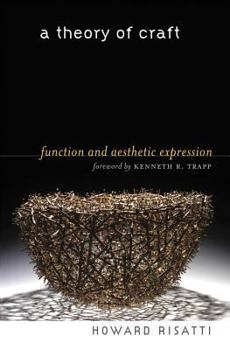A Theory of Craft: Function and Aesthetic Expression
Select Format
Select Condition 
Book Overview
What is craft? How is it different from fine art or design? In A Theory of Craft, Howard Risatti examines these issues by comparing handmade ceramics, glass, metalwork, weaving, and furniture to painting, sculpture, photography, and machine-made design from Bauhaus to the Memphis Group. He describes craft as uniquely blending function with a deeper expression of human values that transcend culture, time, and space. Craft must articulate a role...
Format:Hardcover
Language:English
ISBN:0807831352
ISBN13:9780807831359
Release Date:October 2007
Publisher:University of North Carolina Press
Length:352 Pages
Weight:1.35 lbs.
Dimensions:1.0" x 6.1" x 9.3"
Customer Reviews
1 rating
Thoughtful, in-depth, interesting look at the art/craft binary
Published by Thriftbooks.com User , 15 years ago
This is a very well-written and easy to read book that examines what craft is, and its place in the world. Risatti looks at the properties of craft objects and discusses how they different from art objects. He examines other writer's work as it relates to craft, e.g. Aristotle, Schopenhauer, Kant, Simmel and particularly Heidegger, whose ideas are discussed throughout the book. The text is liberally footnoted, and original authors are always fully cited so you can easily locate the text under discussion for yourself. Risatti's main thesis is that craft objects are defined by having a connection to the body, and being formed around physical purpose and function. Interestingly he believes that media often considered craft, such as jewellery, textile design, tiles, architectural ornamentation etc. belong in a separate category of "adornment" which should be separate from craft objects, situated part way between craft and art (p. 39-40). As I am personally most interested in textile-based craft this made the book a little frustrating for me, as Risatti's subsequent discussions do not encompass these media. However he does discuss textiles in places where they are involved with craft/art intersections, such as a very interesting piece about Robert Rauschenberg's work 'Bed' (1955), in which the artist partly painted over a bed quilt with oil paint and pastel (p.132-134). I particularly liked the chapter 'Thingness of the thing' (p.139-149) as this is a succinct and accessible unpicking of Heidegger's 'The Thing', and would be a useful read for undergraduates studying design. Risatti actually draws a huge distinction between the designer and the craftsperson. He states that "in the process of designing the designer does not directly encounter the physical world of matter: no dialogical/dialectical process occurs, no give and take...between idea, form and matter through which they eventually come together as a fully fledged design object" (p. 171). Risatti states that a designer is "compelled to conceive objects for mass production" (p.173) and his discussion of the implication of multiples in the form of copies and reproductions is very thought-provoking. At first I was inclined to take issues with the claim that designers are forced to remove themselves from the dialogic relationship with materials, and then sadly I found myself forced to admit Risatti was right, and I just didn't want to admit the real-world day-to-day limitations of design. So, overall, a really interesting book, and I recommend it to anyone interested in crafts from an academic perspective.





